2003 FORD SUPER DUTY service
[x] Cancel search: servicePage 31 of 56
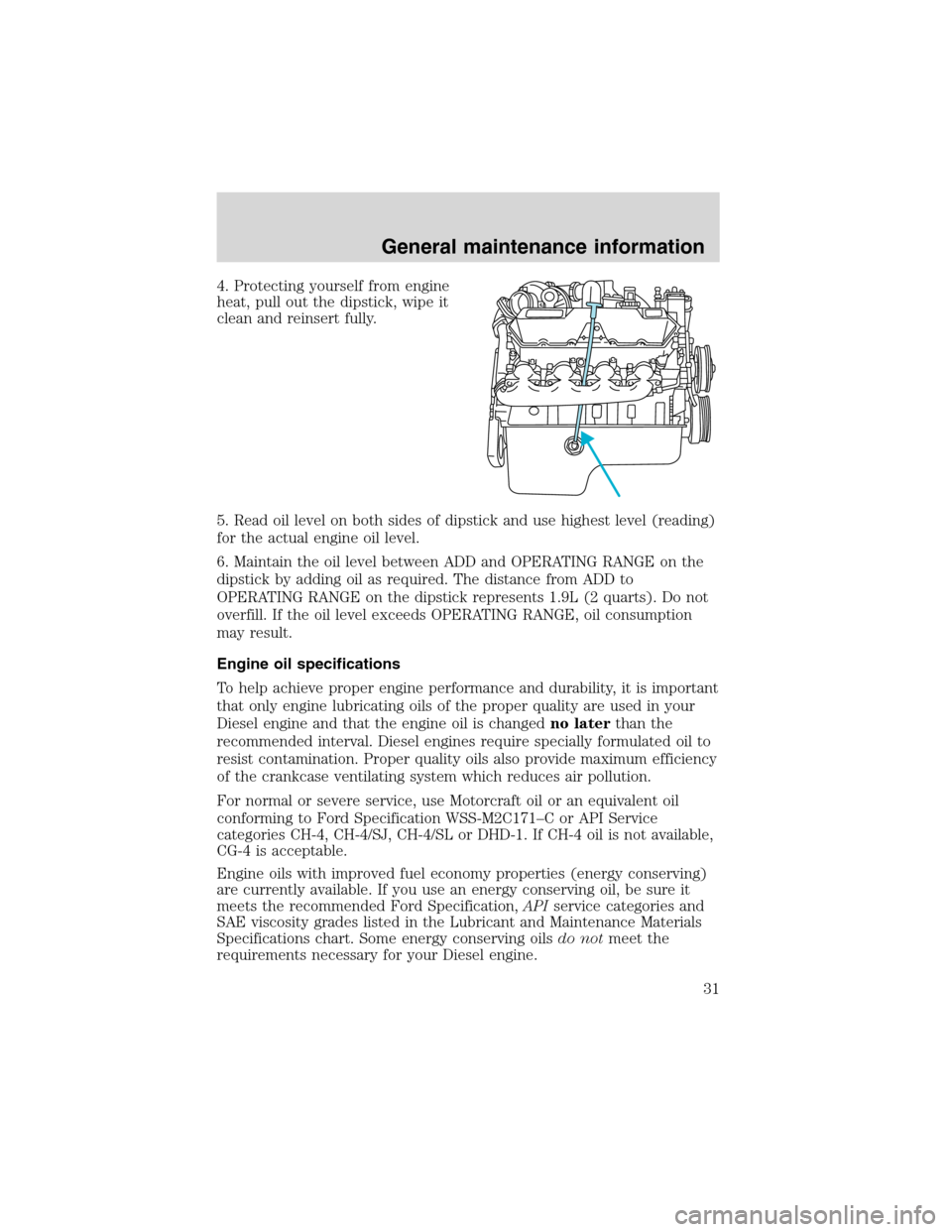
4. Protecting yourself from engine
heat, pull out the dipstick, wipe it
clean and reinsert fully.
5. Read oil level on both sides of dipstick and use highest level (reading)
for the actual engine oil level.
6. Maintain the oil level between ADD and OPERATING RANGE on the
dipstick by adding oil as required. The distance from ADD to
OPERATING RANGE on the dipstick represents 1.9L (2 quarts). Do not
overfill. If the oil level exceeds OPERATING RANGE, oil consumption
may result.
Engine oil specifications
To help achieve proper engine performance and durability, it is important
that only engine lubricating oils of the proper quality are used in your
Diesel engine and that the engine oil is changedno laterthan the
recommended interval. Diesel engines require specially formulated oil to
resist contamination. Proper quality oils also provide maximum efficiency
of the crankcase ventilating system which reduces air pollution.
For normal or severe service, use Motorcraft oil or an equivalent oil
conforming to Ford Specification WSS-M2C171–C or API Service
categories CH-4, CH-4/SJ, CH-4/SL or DHD-1. If CH-4 oil is not available,
CG-4 is acceptable.
Engine oils with improved fuel economy properties (energy conserving)
are currently available. If you use an energy conserving oil, be sure it
meets the recommended Ford Specification,APIservice categories and
SAE viscosity grades listed in the Lubricant and Maintenance Materials
Specifications chart. Some energy conserving oilsdo notmeet the
requirements necessary for your Diesel engine.
General maintenance information
31
Page 32 of 56
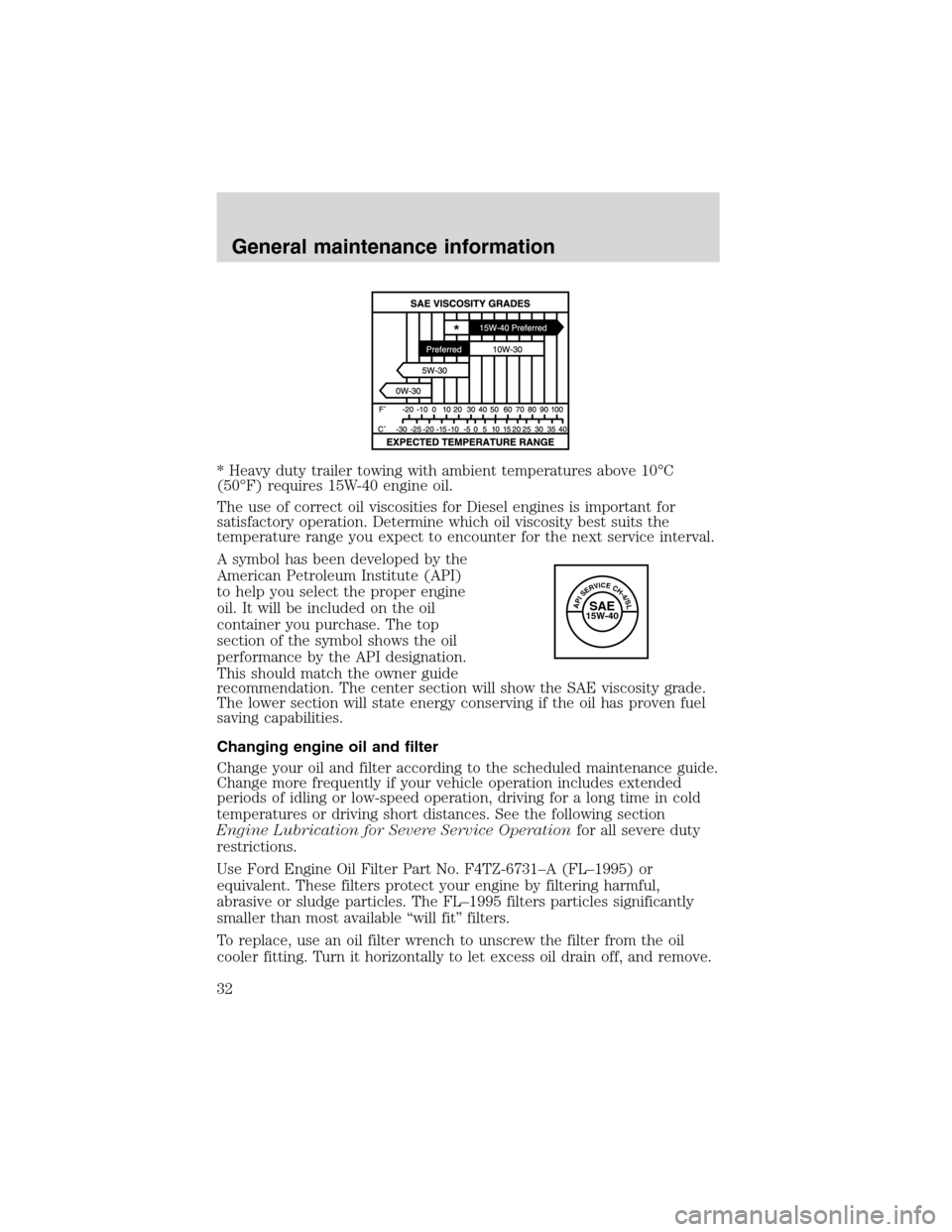
* Heavy duty trailer towing with ambient temperatures above 10°C
(50°F) requires 15W-40 engine oil.
The use of correct oil viscosities for Diesel engines is important for
satisfactory operation. Determine which oil viscosity best suits the
temperature range you expect to encounter for the next service interval.
A symbol has been developed by the
American Petroleum Institute (API)
to help you select the proper engine
oil. It will be included on the oil
container you purchase. The top
section of the symbol shows the oil
performance by the API designation.
This should match the owner guide
recommendation. The center section will show the SAE viscosity grade.
The lower section will state energy conserving if the oil has proven fuel
saving capabilities.
Changing engine oil and filter
Change your oil and filter according to the scheduled maintenance guide.
Change more frequently if your vehicle operation includes extended
periods of idling or low-speed operation, driving for a long time in cold
temperatures or driving short distances. See the following section
Engine Lubrication for Severe Service Operationfor all severe duty
restrictions.
Use Ford Engine Oil Filter Part No. F4TZ-6731–A (FL–1995) or
equivalent. These filters protect your engine by filtering harmful,
abrasive or sludge particles. The FL–1995 filters particles significantly
smaller than most available“will fit”filters.
To replace, use an oil filter wrench to unscrew the filter from the oil
cooler fitting. Turn it horizontally to let excess oil drain off, and remove.
APISERVICECH-4/SLSAE15W-40
General maintenance information
32
Page 33 of 56
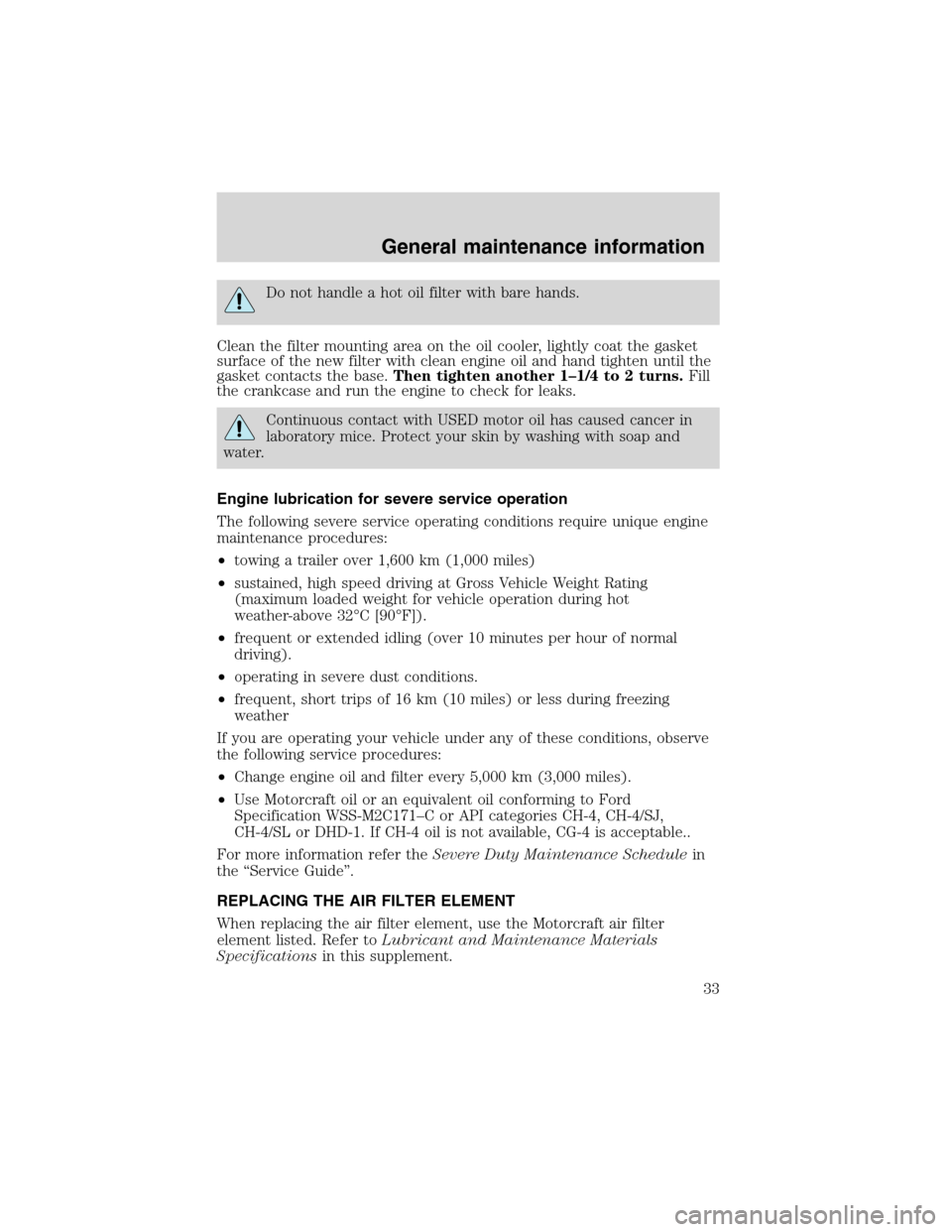
Do not handle a hot oil filter with bare hands.
Clean the filter mounting area on the oil cooler, lightly coat the gasket
surface of the new filter with clean engine oil and hand tighten until the
gasket contacts the base.Then tighten another 1–1/4 to 2 turns.Fill
the crankcase and run the engine to check for leaks.
Continuous contact with USED motor oil has caused cancer in
laboratory mice. Protect your skin by washing with soap and
water.
Engine lubrication for severe service operation
The following severe service operating conditions require unique engine
maintenance procedures:
•towing a trailer over 1,600 km (1,000 miles)
•sustained, high speed driving at Gross Vehicle Weight Rating
(maximum loaded weight for vehicle operation during hot
weather-above 32°C [90°F]).
•frequent or extended idling (over 10 minutes per hour of normal
driving).
•operating in severe dust conditions.
•frequent, short trips of 16 km (10 miles) or less during freezing
weather
If you are operating your vehicle under any of these conditions, observe
the following service procedures:
•Change engine oil and filter every 5,000 km (3,000 miles).
•Use Motorcraft oil or an equivalent oil conforming to Ford
Specification WSS-M2C171–C or API categories CH-4, CH-4/SJ,
CH-4/SL or DHD-1. If CH-4 oil is not available, CG-4 is acceptable..
For more information refer theSevere Duty Maintenance Schedulein
the“Service Guide”.
REPLACING THE AIR FILTER ELEMENT
When replacing the air filter element, use the Motorcraft air filter
element listed. Refer toLubricant and Maintenance Materials
Specificationsin this supplement.
General maintenance information
33
Page 35 of 56

2. Open the hood. Place an
appropriate container under the
filter drain under the vehicle.
3. Locate the fuel filter drain valve. If necessary, remove the engine
appearance cover. Refer toEngine Compartmentin theService points
chapter.
4.On F-Series and Excursion
models,open fuel filter drain valve
by turning clockwise. Allow to drain
for approximately 25 seconds or
until clean fuel is observed. Close
filter drain valve by turning
counterclockwise until firmly seated.
DRAIN
CLOSE
General maintenance information
35
Page 37 of 56
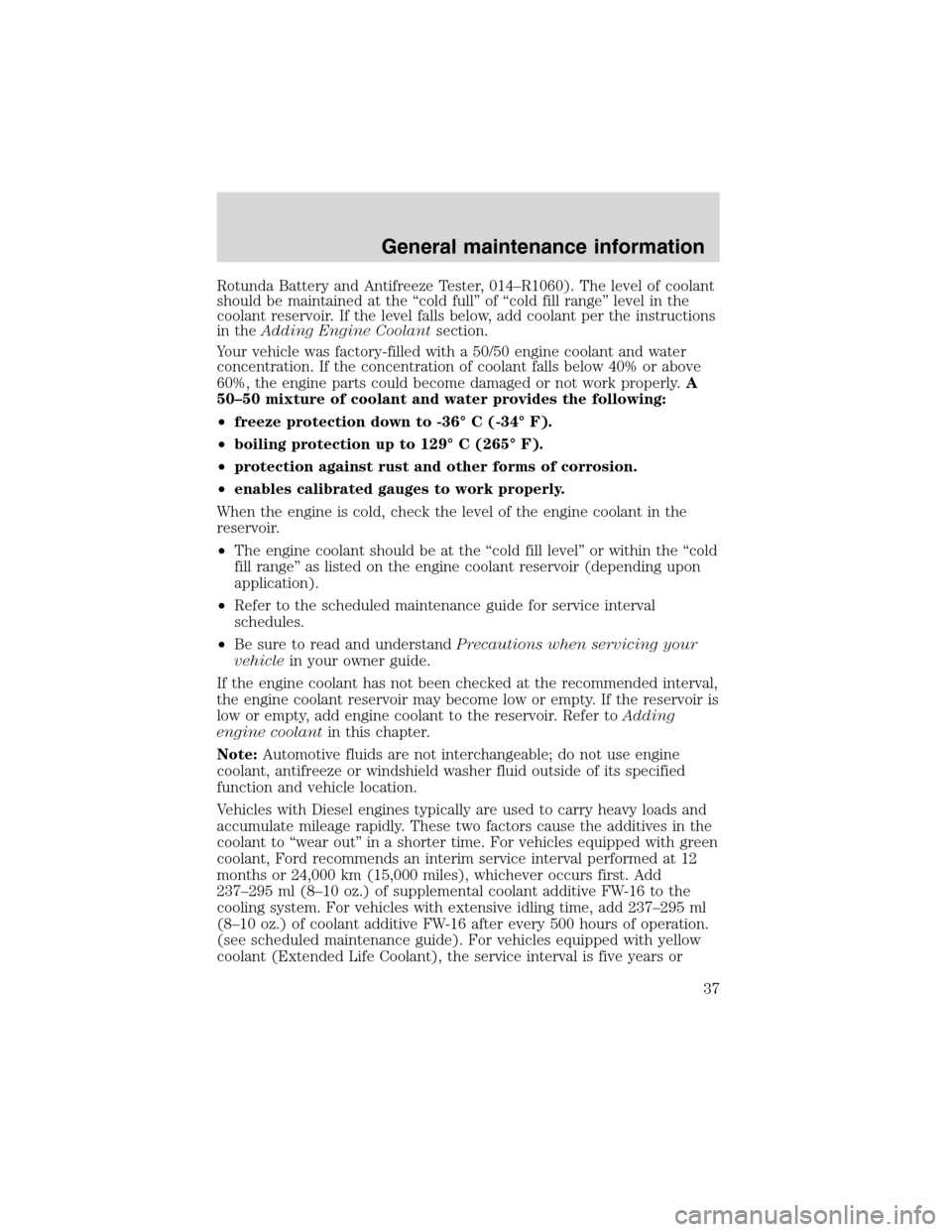
Rotunda Battery and Antifreeze Tester, 014–R1060). The level of coolant
should be maintained at the“cold full”of“cold fill range”level in the
coolant reservoir. If the level falls below, add coolant per the instructions
in theAdding Engine Coolantsection.
Your vehicle was factory-filled with a 50/50 engine coolant and water
concentration. If the concentration of coolant falls below 40% or above
60%, the engine parts could become damaged or not work properly.A
50–50 mixture of coolant and water provides the following:
•freeze protection down to -36°C (-34°F).
•boiling protection up to 129°C (265°F).
•protection against rust and other forms of corrosion.
•enables calibrated gauges to work properly.
When the engine is cold, check the level of the engine coolant in the
reservoir.
•The engine coolant should be at the“cold fill level”or within the“cold
fill range”as listed on the engine coolant reservoir (depending upon
application).
•Refer to the scheduled maintenance guide for service interval
schedules.
•Be sure to read and understandPrecautions when servicing your
vehiclein your owner guide.
If the engine coolant has not been checked at the recommended interval,
the engine coolant reservoir may become low or empty. If the reservoir is
low or empty, add engine coolant to the reservoir. Refer toAdding
engine coolantin this chapter.
Note:Automotive fluids are not interchangeable; do not use engine
coolant, antifreeze or windshield washer fluid outside of its specified
function and vehicle location.
Vehicles with Diesel engines typically are used to carry heavy loads and
accumulate mileage rapidly. These two factors cause the additives in the
coolant to“wear out”in a shorter time. For vehicles equipped with green
coolant, Ford recommends an interim service interval performed at 12
months or 24,000 km (15,000 miles), whichever occurs first. Add
237–295 ml (8–10 oz.) of supplemental coolant additive FW-16 to the
cooling system. For vehicles with extensive idling time, add 237–295 ml
(8–10 oz.) of coolant additive FW-16 after every 500 hours of operation.
(see scheduled maintenance guide). For vehicles equipped with yellow
coolant (Extended Life Coolant), the service interval is five years or
General maintenance information
37
Page 38 of 56

100,000 miles and three years or 50,000 miles thereafter. Vehicles
equipped with the Extended Life Coolant do not require any additives.
Adding engine coolant
When adding coolant, make sure it is a 50/50 mixture of engine coolant
and distilled water. Add the mixture to the coolant reservoir,when the
engine is cool, until the appropriate fill level is obtained.
Do not add engine coolant when the engine is hot. Steam and
scalding liquids released from a hot cooling system can burn you
badly. Also, you can be burned if you spill coolant on hot engine parts.
Do not put engine coolant in the windshield washer fluid
container. If sprayed on the windshield, engine coolant could
make it difficult to see through the windshield.
The cooling system in your vehicle is filled with either green-colored
Motorcraft Premium Engine Coolant meeting Ford specification
ESE-M97B44–A or yellow-colored Motorcraft Premium Gold Engine
Coolant meeting Ford Specification WSS-M97B51–A1. To determine your
vehicle’s coolant type (color), check your coolant reservoir.
•Add Motorcraft Premium Engine Coolant (green-colored),
VC-4–A (U.S.) or CXC-10 (Canada) or Motorcraft Premium
Gold Engine Coolant (yellow-colored), VC-7–A, depending on
the type of coolant originally equipped in your vehicle.If you
are unsure which type of coolant your vehicle requires, check your
coolant reservoir or contact your local dealer.
•Do not add/mix an orange-colored, extended life coolant such
as Motorcraft Speciality Orange Engine Coolant, VC-2 (US) or
CXC-209 (Canada), meeting Ford specification WSS-M97B44–D
with the factory-filled coolant.Mixing Motorcraft Speciality Orange
Engine Coolant or any orange-colored extended life product with your
factory filled coolant can result in degraded corrosion protection.
•A large amount of water without engine coolant may be added, in case
of emergency, to reach a vehicle service location. In this instance, the
cooling system must be drained and refilled with a 50/50 mixture of
engine coolant and distilled water as soon as possible. Water alone
(without engine coolant) can cause engine damage from corrosion,
overheating or freezing.
General maintenance information
38
Page 40 of 56
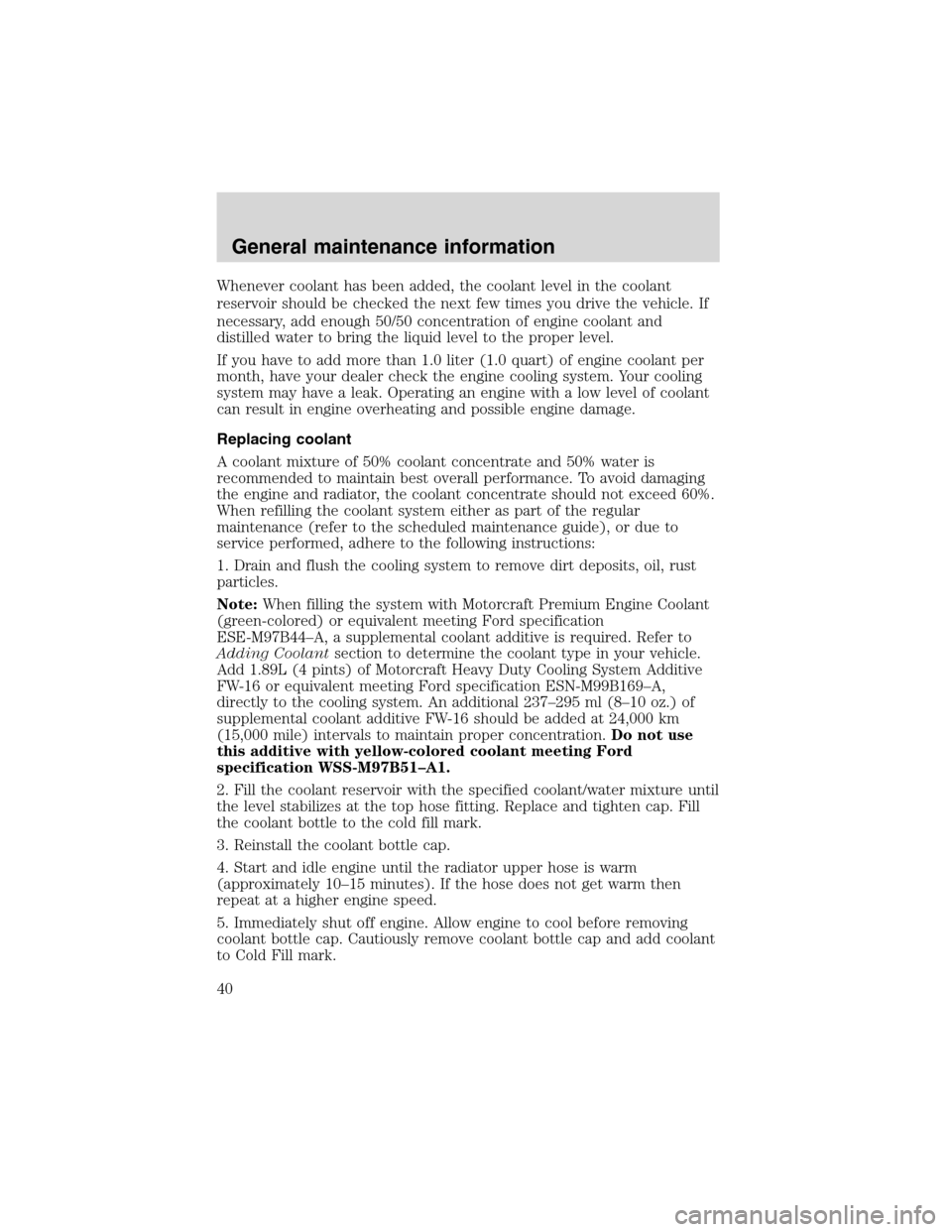
Whenever coolant has been added, the coolant level in the coolant
reservoir should be checked the next few times you drive the vehicle. If
necessary, add enough 50/50 concentration of engine coolant and
distilled water to bring the liquid level to the proper level.
If you have to add more than 1.0 liter (1.0 quart) of engine coolant per
month, have your dealer check the engine cooling system. Your cooling
system may have a leak. Operating an engine with a low level of coolant
can result in engine overheating and possible engine damage.
Replacing coolant
A coolant mixture of 50% coolant concentrate and 50% water is
recommended to maintain best overall performance. To avoid damaging
the engine and radiator, the coolant concentrate should not exceed 60%.
When refilling the coolant system either as part of the regular
maintenance (refer to the scheduled maintenance guide), or due to
service performed, adhere to the following instructions:
1. Drain and flush the cooling system to remove dirt deposits, oil, rust
particles.
Note:When filling the system with Motorcraft Premium Engine Coolant
(green-colored) or equivalent meeting Ford specification
ESE-M97B44–A, a supplemental coolant additive is required. Refer to
Adding Coolantsection to determine the coolant type in your vehicle.
Add 1.89L (4 pints) of Motorcraft Heavy Duty Cooling System Additive
FW-16 or equivalent meeting Ford specification ESN-M99B169–A,
directly to the cooling system. An additional 237–295 ml (8–10 oz.) of
supplemental coolant additive FW-16 should be added at 24,000 km
(15,000 mile) intervals to maintain proper concentration.Do not use
this additive with yellow-colored coolant meeting Ford
specification WSS-M97B51–A1.
2. Fill the coolant reservoir with the specified coolant/water mixture until
the level stabilizes at the top hose fitting. Replace and tighten cap. Fill
the coolant bottle to the cold fill mark.
3. Reinstall the coolant bottle cap.
4. Start and idle engine until the radiator upper hose is warm
(approximately 10–15 minutes). If the hose does not get warm then
repeat at a higher engine speed.
5. Immediately shut off engine. Allow engine to cool before removing
coolant bottle cap. Cautiously remove coolant bottle cap and add coolant
to Cold Fill mark.
General maintenance information
40
Page 44 of 56

VEHICLE EMISSIONS CONTROL INFORMATION (VECI)
Emissions information appears on
the VECI decal on the engine valve
cover. This decal identifies engine
displacement and provides certain
engine specifications.
SCHEDULED MAINTENANCE SERVICES
Refer to your scheduled maintenance guide for details of maintenance on
your vehicle.
If you are using your vehicle in a manner in which it will remain
stationary (door to door service, taxi, etc.), then it is recommended that
you change the engine oil every 200 engine hours as opposed to a
mileage limit. Since most vehicles are not equipped with hourmeters, it
may be necessary for you to approximate your time and plan engine oil
and filter changes accordingly.
Any modification of the emissions control system could create liability
under federal law (U.S.) if made prior to sale and registration, under the
laws of some states if made thereafter. Further, federal law prohibits
vehicle manufacturers, dealers and other persons engaged in the
business of repairing, servicing, selling, leasing or trading motor vehicles
as well as fleet operations from knowingly removing or rendering an
emissions control system inoperative after sale and delivery to an
ultimate purchaser. In Canada, modifications of the emissions control
system could create liability under applicable federal or provincial laws.
Scheduled maintenance
44